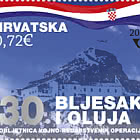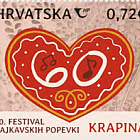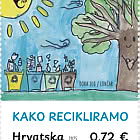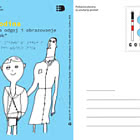Croatian Fauna
LOGGERHEAD SEA TURTLE
The loggerhead sea turtle (Caretta caretta) is the most abundant sea turtle in the Adriatic and the Mediterranean Sea. Its bony oval shell is reddish-brown in colour and may grow longer than one meter in adults. Loggerhead sea turtles live to 60 years and reach sexual maturity at age 15 to 20 years. Every four years, the females lay eggs on the sandy beaches where they hatched. They lay three to four egg clutches during one season, with 80-120 eggs in each clutch. The most important nesting sites of the loggerhead sea turtle are in Greece, Cyprus, and Turkey. After hatching, the hatchlings race to the water’s edge and during the next few days swim towards the safety of the open sea, almost without any rest.
The turtle feeds on various sea invertebrates such as sponges, jellyfish, sea anemones, sea urchins, molluscs, shellfish, and crustaceans. Due to the abundance of prey, the northern Adriatic is an extremely important area for both adult and young turtles who arrive there mostly from the nesting grounds in Greece. Studies have shown that they remain in the Adriatic Sea for several years.
Loggerhead sea turtles face many threats – predators, fishing gear, vessels, destruction of habitats, and pollution, especially with plastic waste. For the conservation of sea turtles, the project “Collective actions for improving the conservation status of the EU sea turtle population – LIFE EUROTURTLES” was started in 2016, in which organizations from Croatia, Italy, Slovenia, Cyprus, Greece, and Malta have been participating, and will end in 2021. This is the first Mediterranean project for the conservation of sea turtles that unites the entire habitat area of the species through conservation activities. The project is worth 5.1 million euros and is co-financed by the European Union with the program LIFE.
The Croatian Natural History Museum coordinates and leads the project and carries out research in order to determine the areas important for the conservation of the loggerhead sea turtle and implements activities to raise the awareness of the public. The Blue World Institute of Marine Research and Conservation also participates in the project in Croatia, undertaking activities to reduce bycatches of sea turtles and managing the sea turtle rescue centre. The project is supported by the City of Zagreb and the Office for Cooperation with NGOs of the Government of the Republic of Croatia.
COMMON BOTTLENOSE DOLPHIN
The common bottlenose dolphin (Tursiops truncatus) is a mammal from the toothed-whale group. It has a distinctive fusiform and hydrodynamic body shape that enables it to swim very fast. The strong tail fluke is used for swimming, while its pectoral flippers are used to turn and stop, and the rounded dorsal fin stabilizes the body. The common bottlenose dolphin breathes air through the blowhole on the top of its head. Its back is mostly darker blue-grey in colour, and its belly is lighter. The dolphins in the Adriatic Sea usually reach three meters in length, and up to 200 kg in weight. The average life expectancy of common bottlenose dolphins is more than 30 years, and sexual maturity occurs at 6 to 7 years of age. Females bear only a single calf every three to five years but may have several of them throughout their lifetime.
The coastal areas in the Adriatic and the Mediterranean Sea are inhabited by smaller communities of common bottlenose dolphins. Within such communities we often find groups of five to six dolphins on average. Adult males can mostly be seen in smaller groups or in pairs. Females with calves are usually in larger groups of 8 to 10 dolphins, for protection. The females in such groups are often related. The longest study of a community of common bottlenose dolphins in the entire Mediterranean has been conducted on Lošinj since 1987.
Common bottlenose dolphins feed on fish and cephalopods. Sound is particularly important to them, and they use it to communicate. Echolocation is used to search for prey – by emitting a high frequency sound that reflects from obstacles, and thus using sound to “light up” their surroundings and easily recognize obstacles and prey. Numerous human activities endanger common bottlenose dolphins: marine pollution, noise pollution, harassment, overfishing, and bycatches in fishing gear reduce their populations.
In order to reduce catch losses for fisheries and the incidence of injuries as well as the entanglement and death of dolphins in fishing gear, the Blue World Institute of Marine Research and Conservation is, together with nine partners from Italy, conducting from 2020 to 2024 the project “LIFE DELFI – reduction of interaction with fisheries”, worth 4.8 million euros, co-financed by the European Union with the LIFE program and the Office for Cooperation with NGOs of the Government of the Republic of Croatia.
GIANT DEVIL RAYS
The giant devil rays (Mobula mobular) are a group of cartilaginous fishes in the family of eagle rays (Myliobatidae). They are also known as „devil fish“, for their two cephalic fins that extrude in front of the head and look like horns. The giant devil ray may have a disk width greater than three meters and may weigh up to 300 kg. It inhabits the pelagic zone of the open sea, and feeds on planktonic organisms, small crustaceans, and small schooling fish which they speed through with a wide-open mouth, filtering the food out of the water.
The giant devil ray is easily recognizable: its back is dark grey to brown in colour, while its belly is almost completely white, and a dark band stretches from eye-to-eye on its head. The giant devil ray’s very long and narrow tail has a serrated barb connected with a poison gland. Until recently, it was thought the giant devil ray is an endemic species of the Mediterranean Sea, but new taxonomic and genetic studies have found it to be a widely distributed species that can be found in almost all seas in tropical and temperate regions. However, the giant devil ray is a special fish. This is an ovoviviparous species, meaning that, even though it is a fish, it does not lay eggs, but a single large egg grows inside the female. After a year and a half, a young fish is hatched, and at that point it may already have a disk width of one meter!
Since it inhabits the pelagic zone, the giant devil ray is rarely spotted, and its presence in the Adriatic Sea is almost unknown. The Blue World Institute scientists’ studies have determined that the giant devil ray frequently appears in the open waters of the Adriatic Sea during the warmer parts of the year, when the organic production increases, as does the growth of the planktonic organisms it feeds on. With colder weather and the disappearance of prey, the giant devil ray migrates towards the warmer parts of the Mediterranean Sea in search of food. New studies estimate that over 3000 rays enter the Adriatic from the Mediterranean Sea during summer. Even though there is no estimate of the abundance of its population in the Mediterranean, it is assumed that the giant devil ray is present in small quantities.
The giant devil ray is not, fortunately, a commercially fished species as the quality of its meat is not particularly high, but bycatches in pelagic trawls and longlines have quite a negative impact on the species, especially considering its very low reproductive capacity.
Assistant Professor Draško Holcer, PhD, and
Renata Brezinščak, B.Eng
Croatia - Recommended stamp issues
WOPA+ recommended stamp issues
| Avatar - Fire and Ash |
| Issued: 03.12.2025 |
| ›New Zealand |
| 50th Anniversary of the Founding of the 24th November Bar Scout |
| Issued: 24.11.2025 |
| ›Montenegro |
| Krisjanis Valdemars |
| Issued: 02.12.2025 |
| ›Latvia |
| Sign Language - Good |
| Issued: 02.12.2025 |
| ›Bosnia and Herzegovina - Republic of Srpska |
| In Memory of the Fallen and Murdered on October 7, 2023 |
| Issued: 08.10.2025 |
| ›Israel |
| Annual Collection Folder (New York) |
| Issued: 05.12.2025 |
| ›United Nations |
| Year Set |
| Issued: 24.11.2025 |
| ›Isle of Man |
| Shipping in the 17th and 18th Centuries - Peat Shipping |
| Issued: 05.12.2025 |
| ›Netherlands |












































